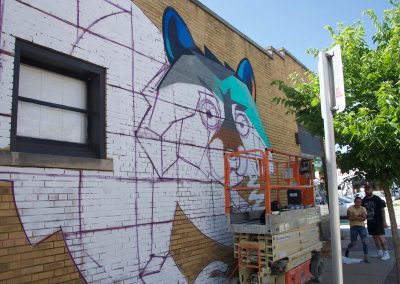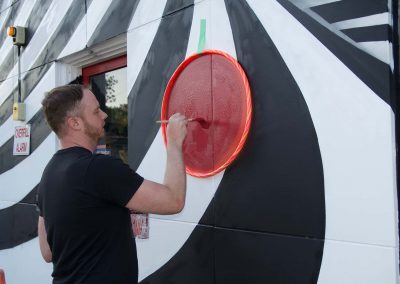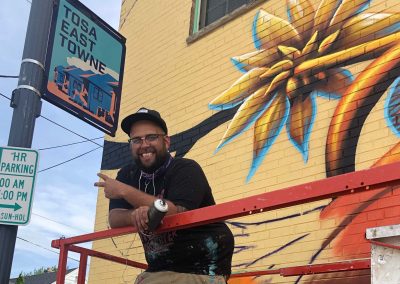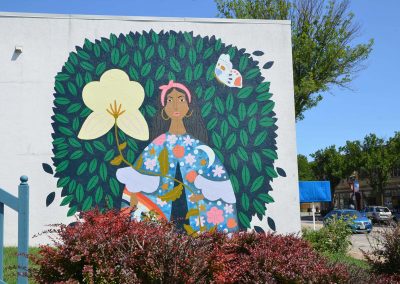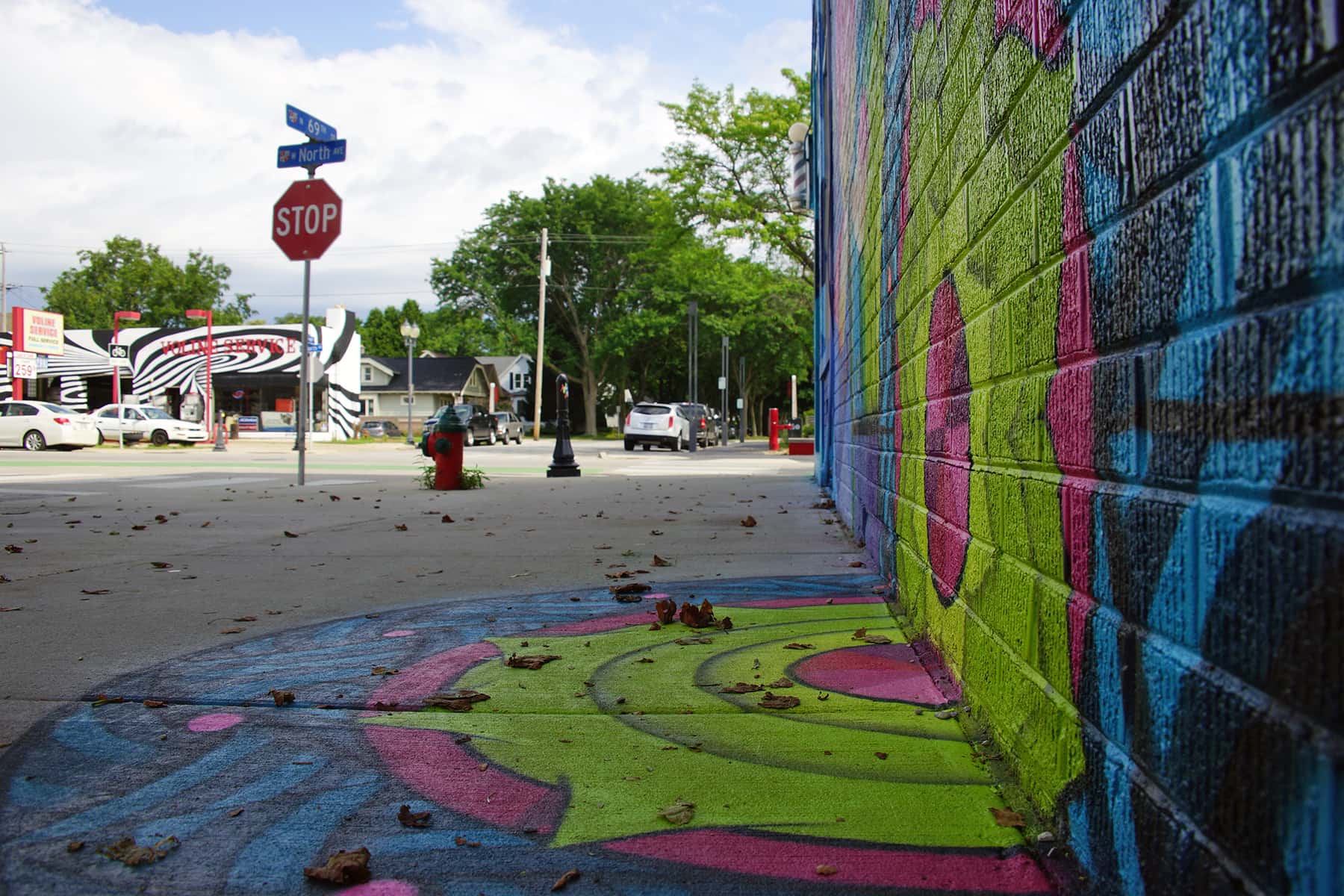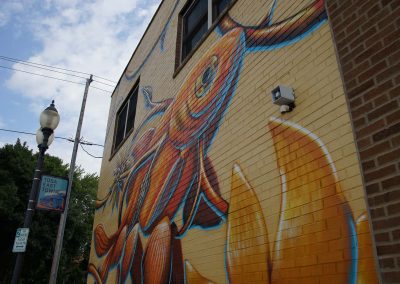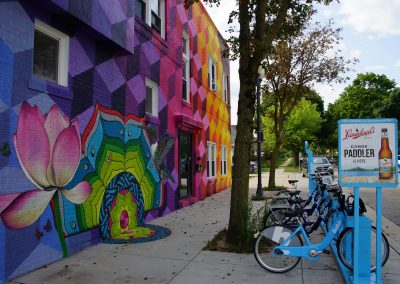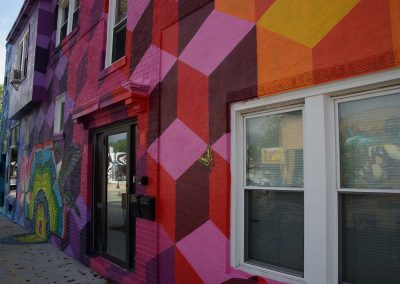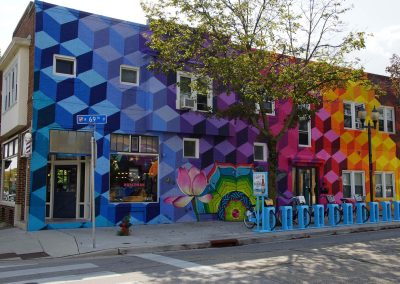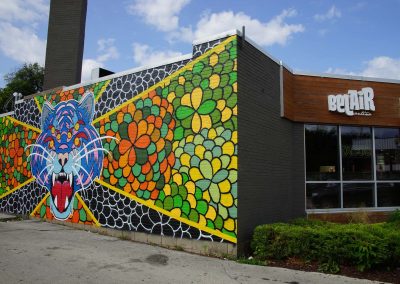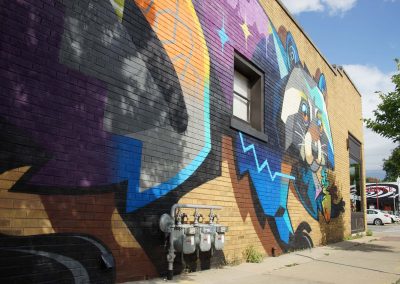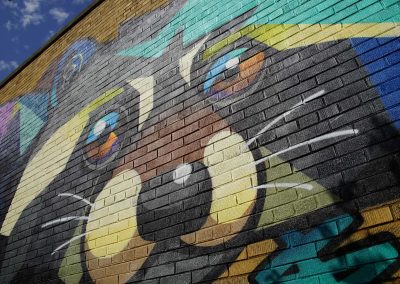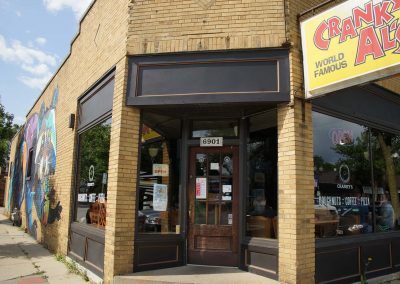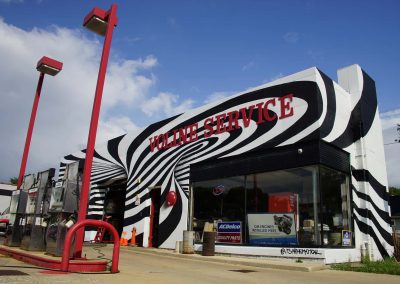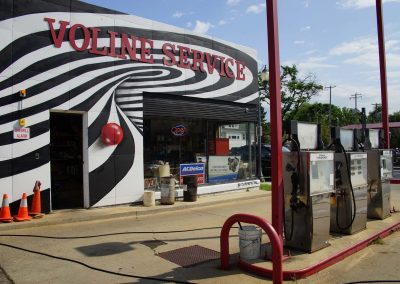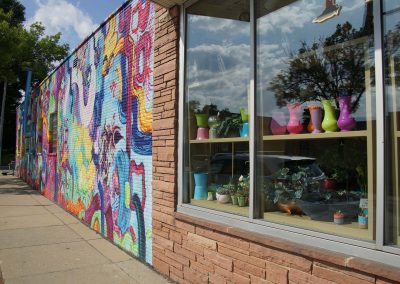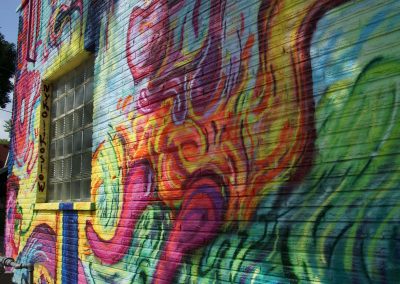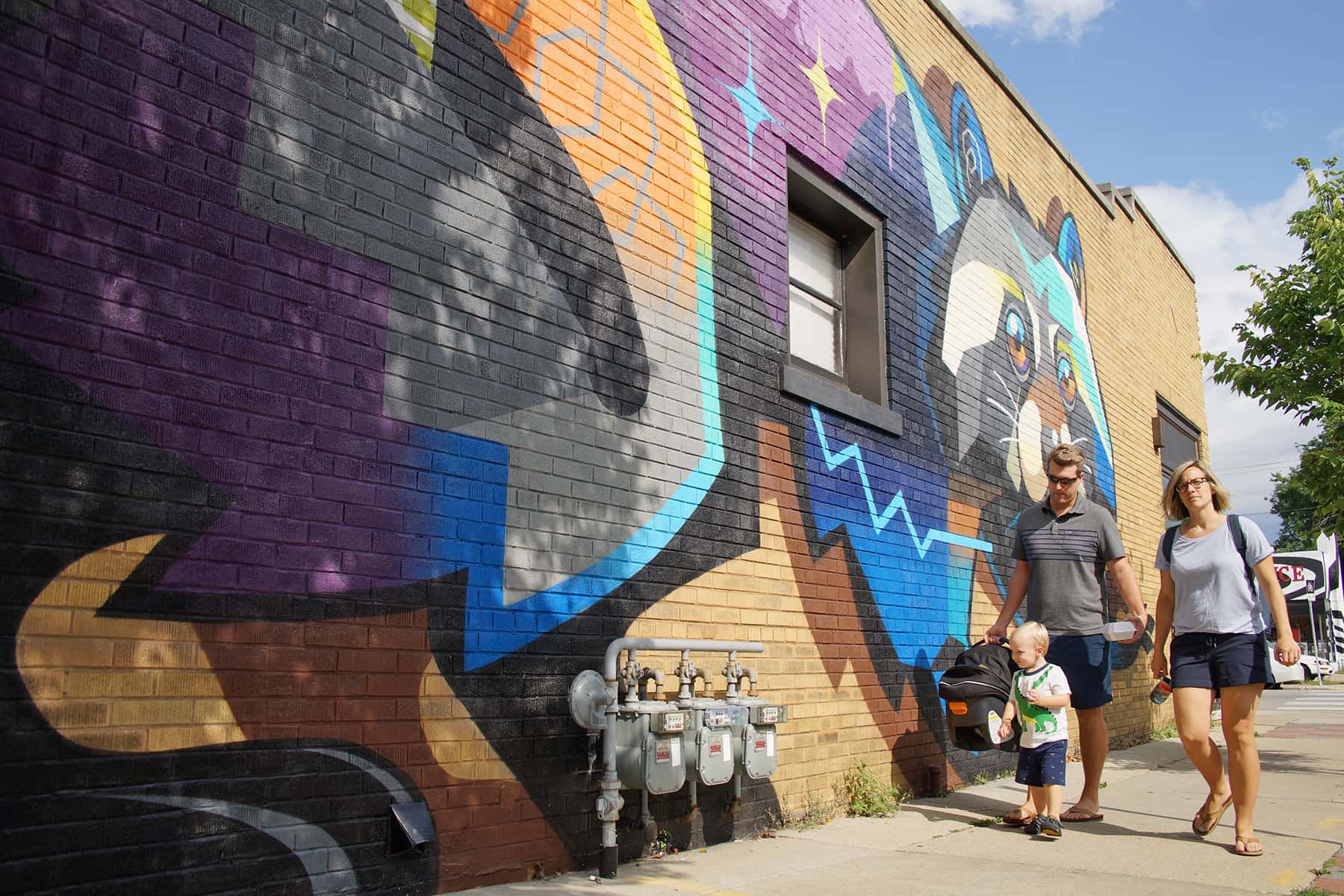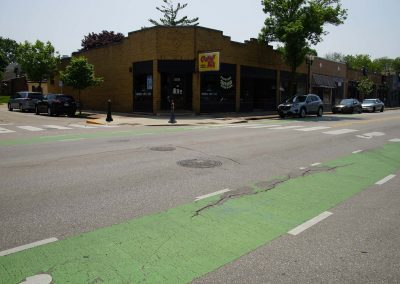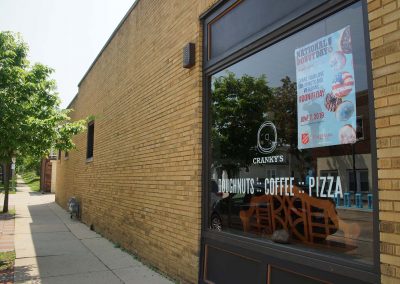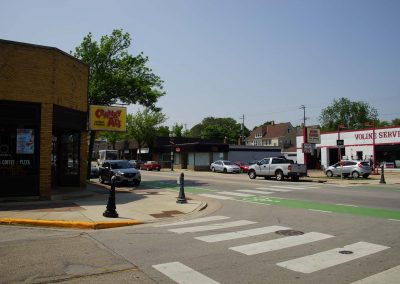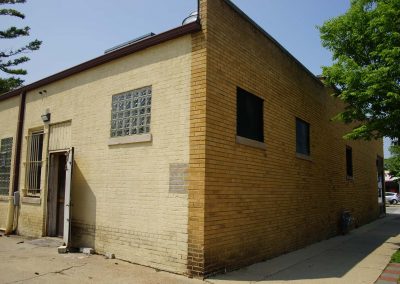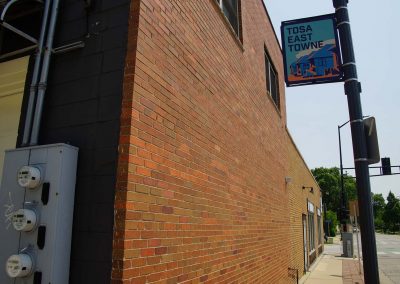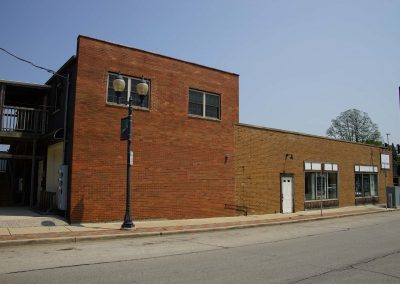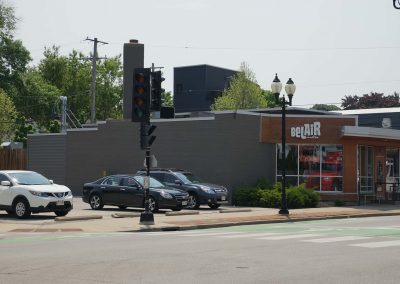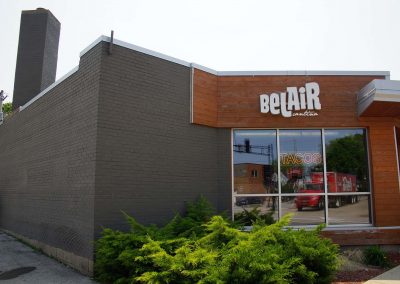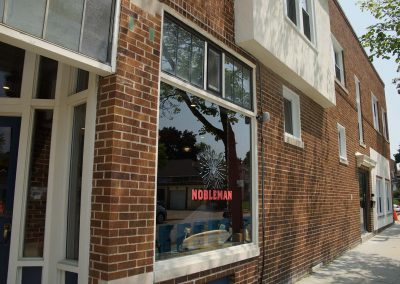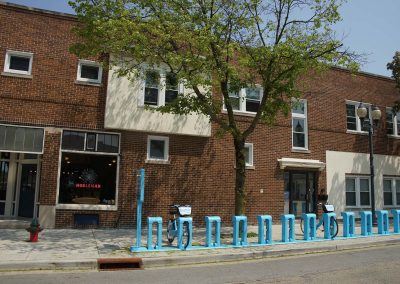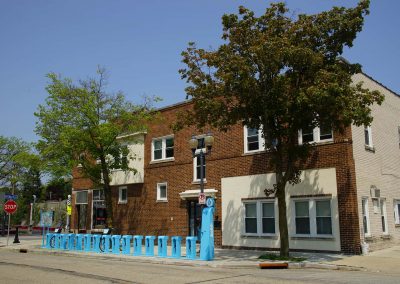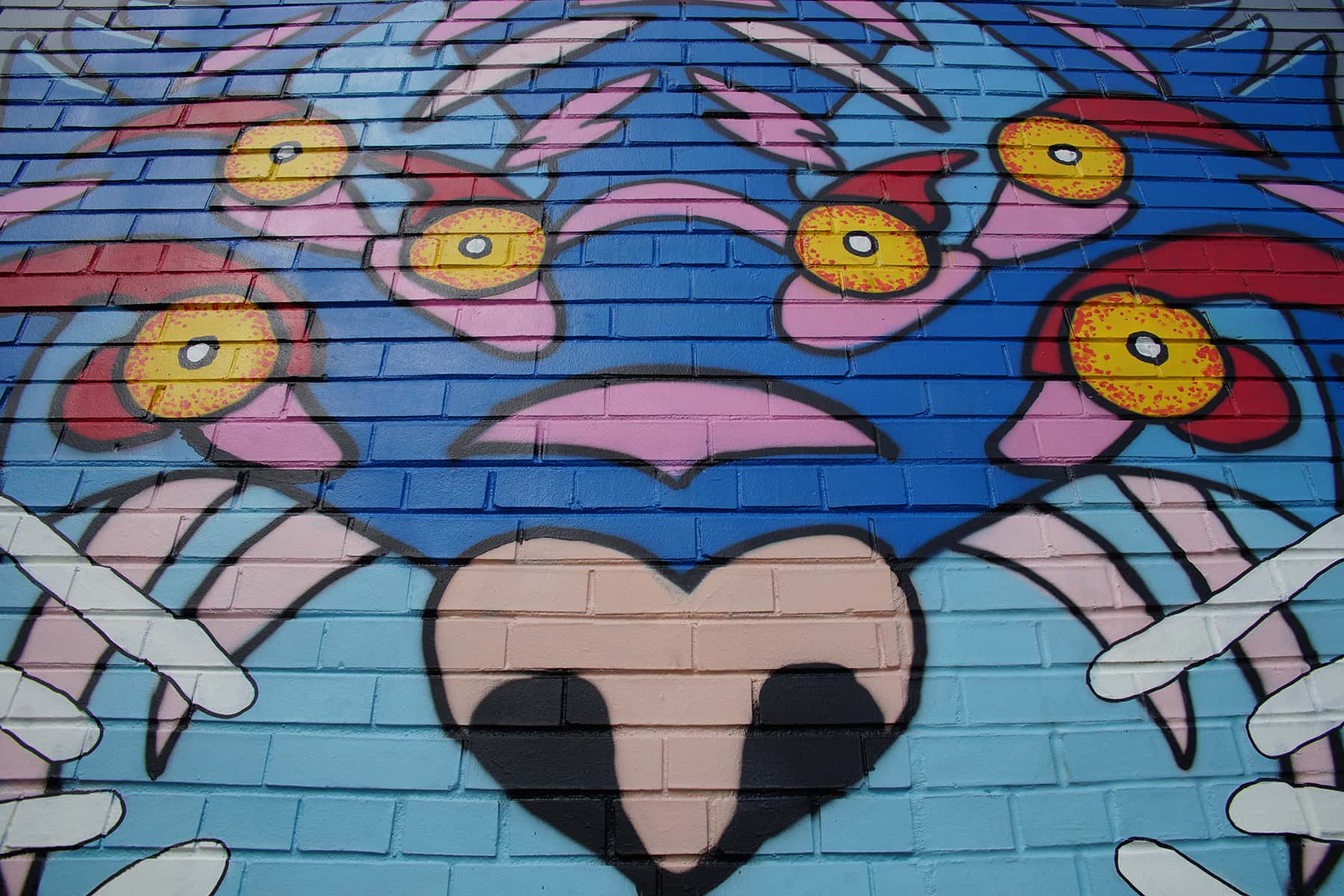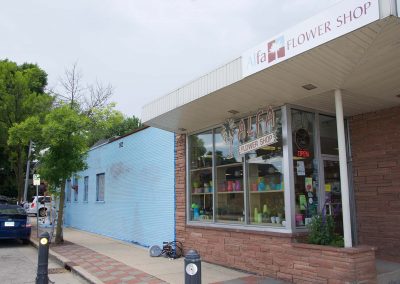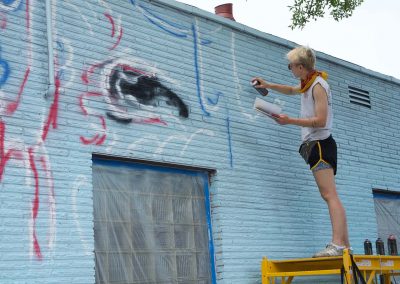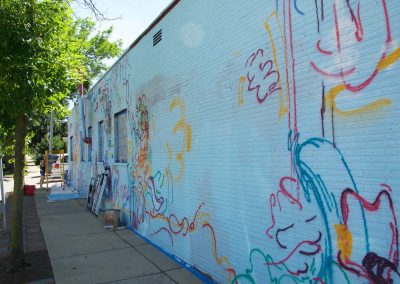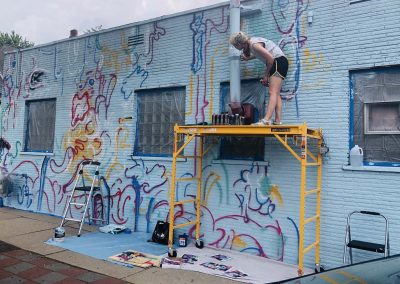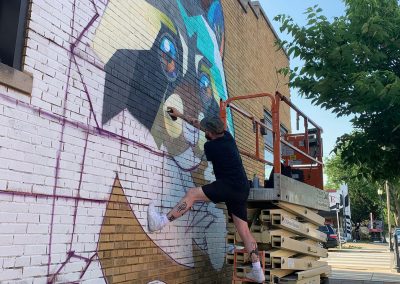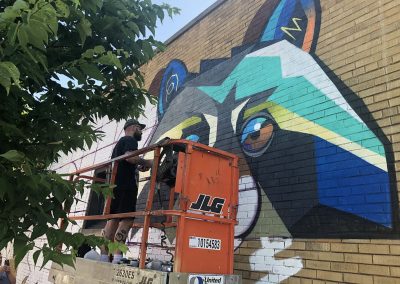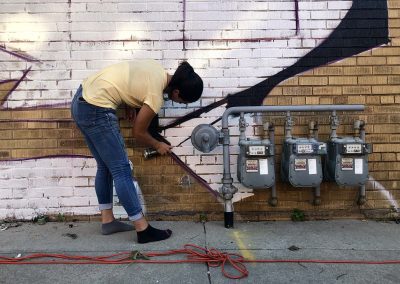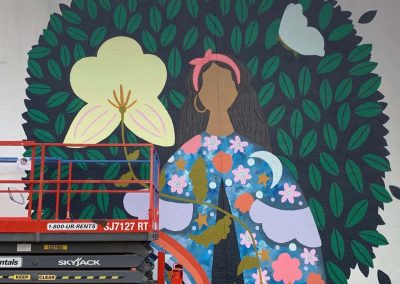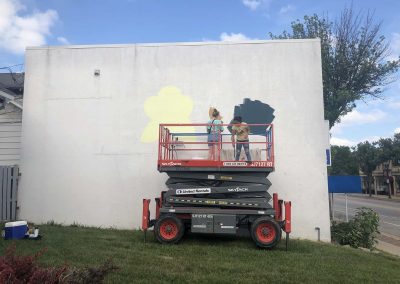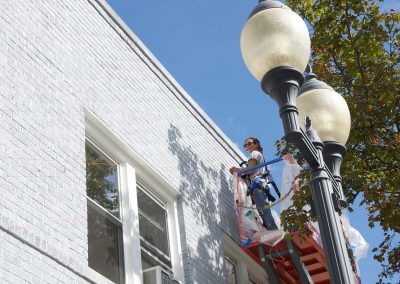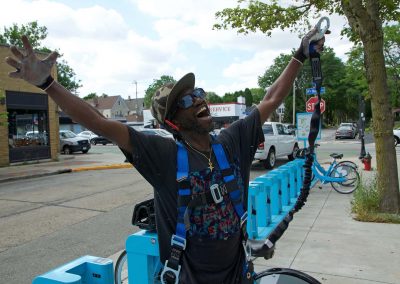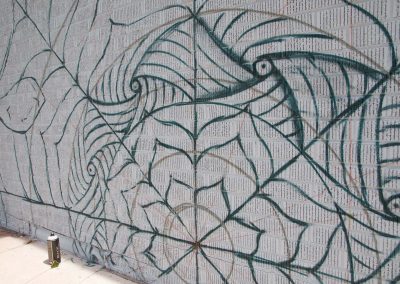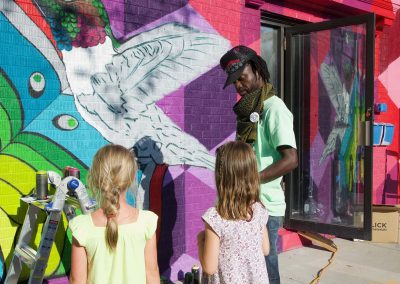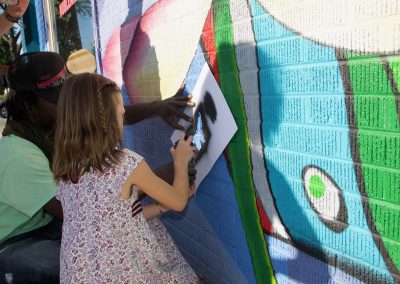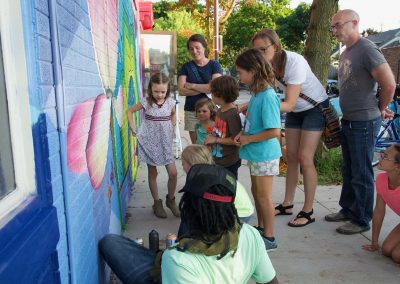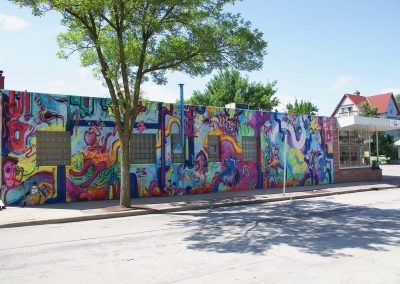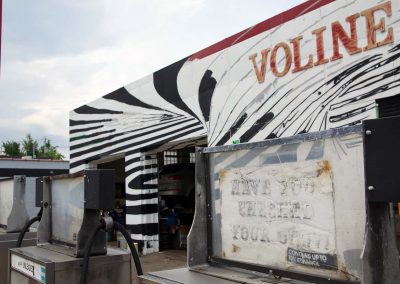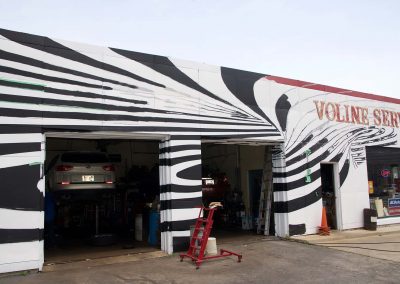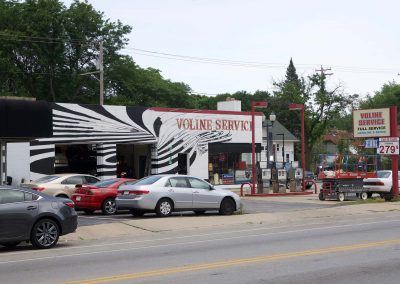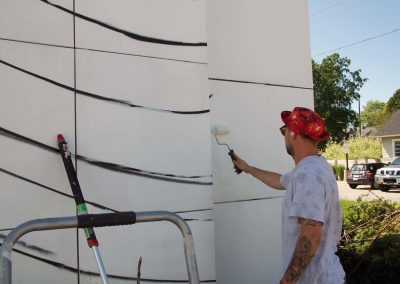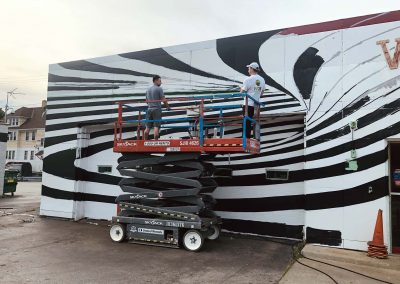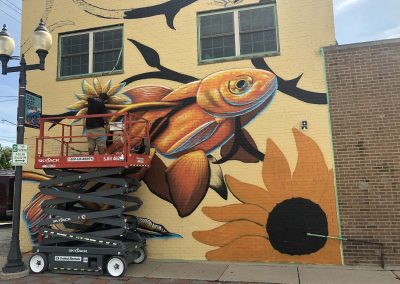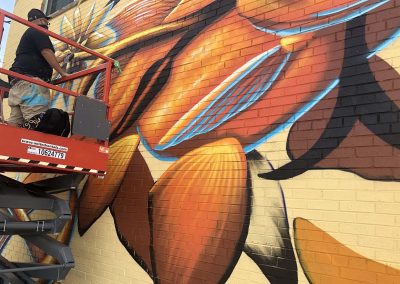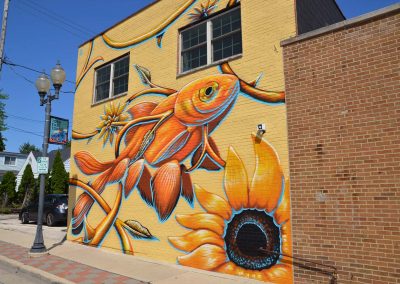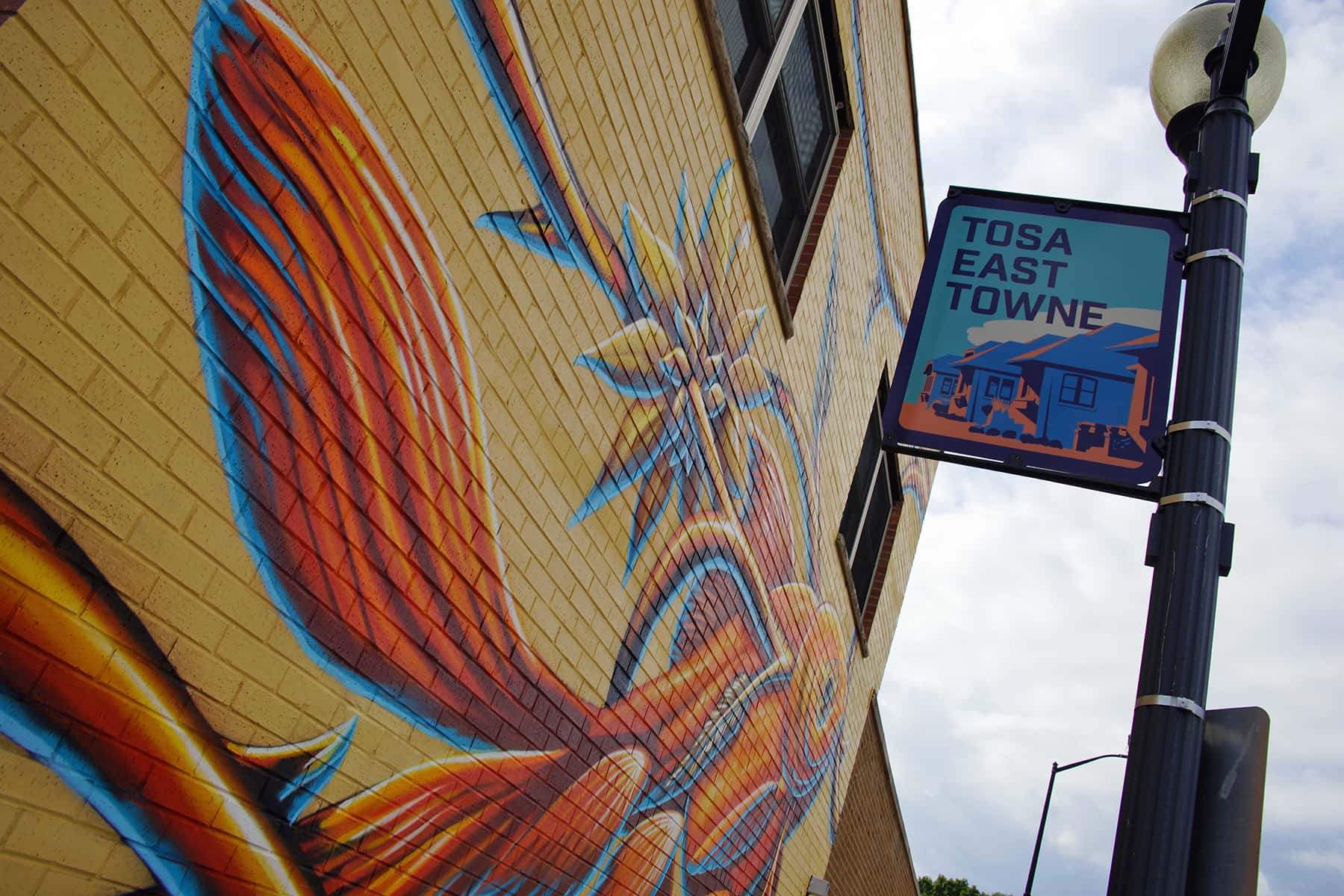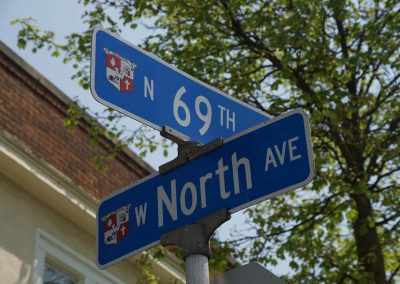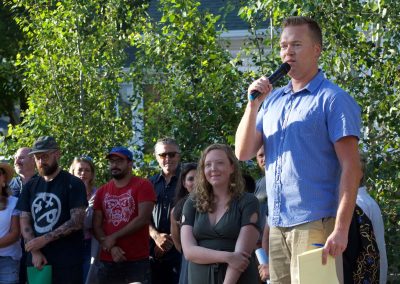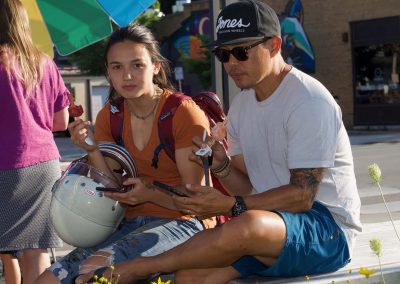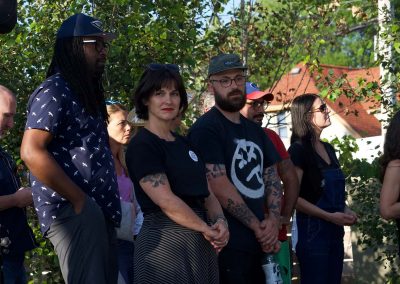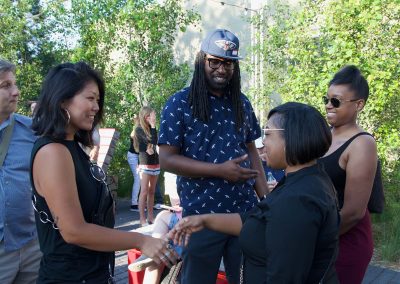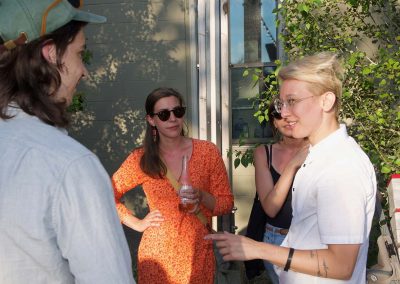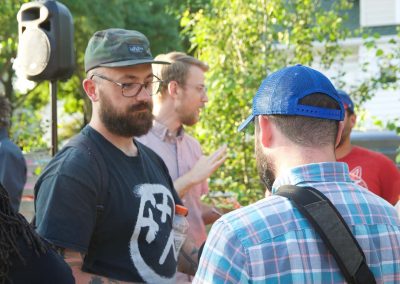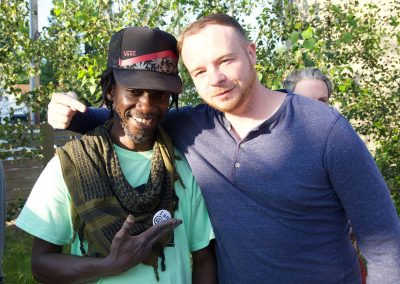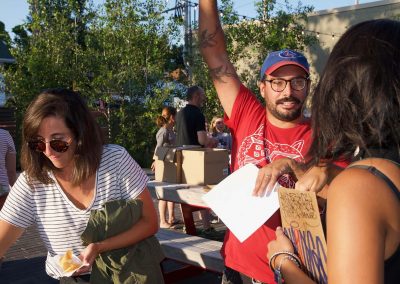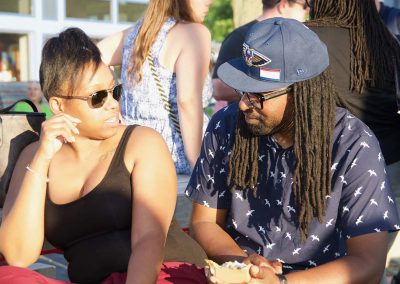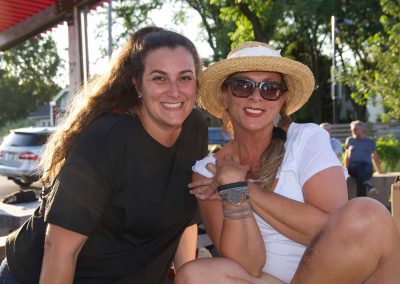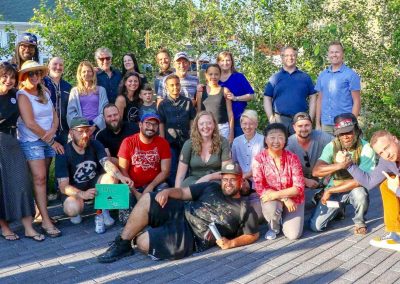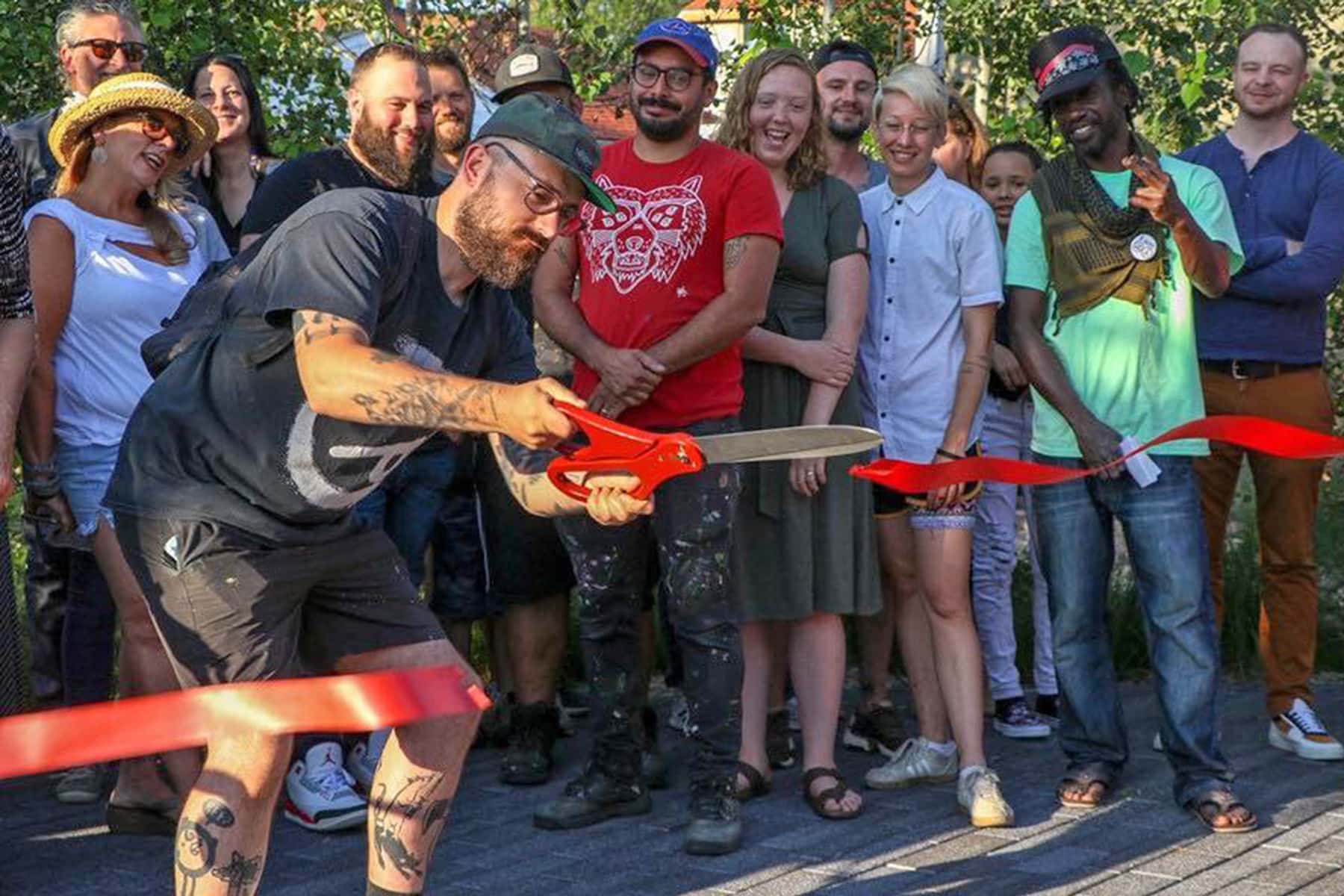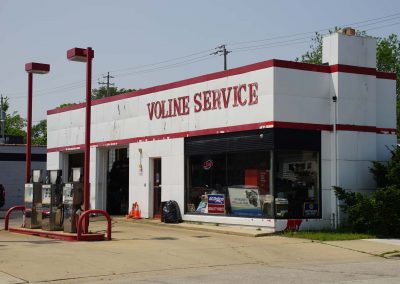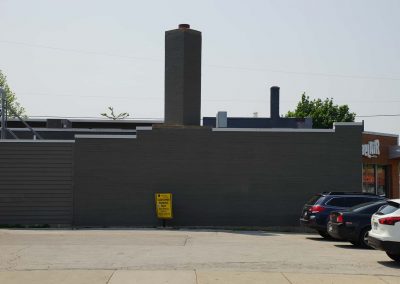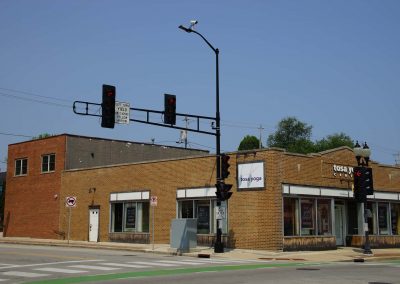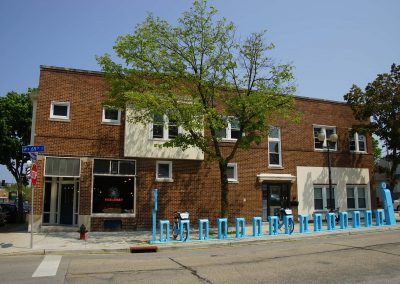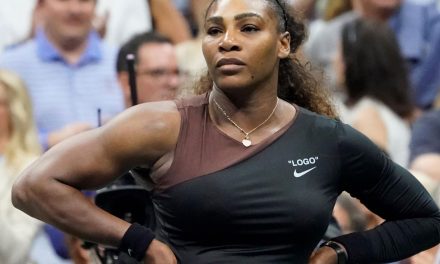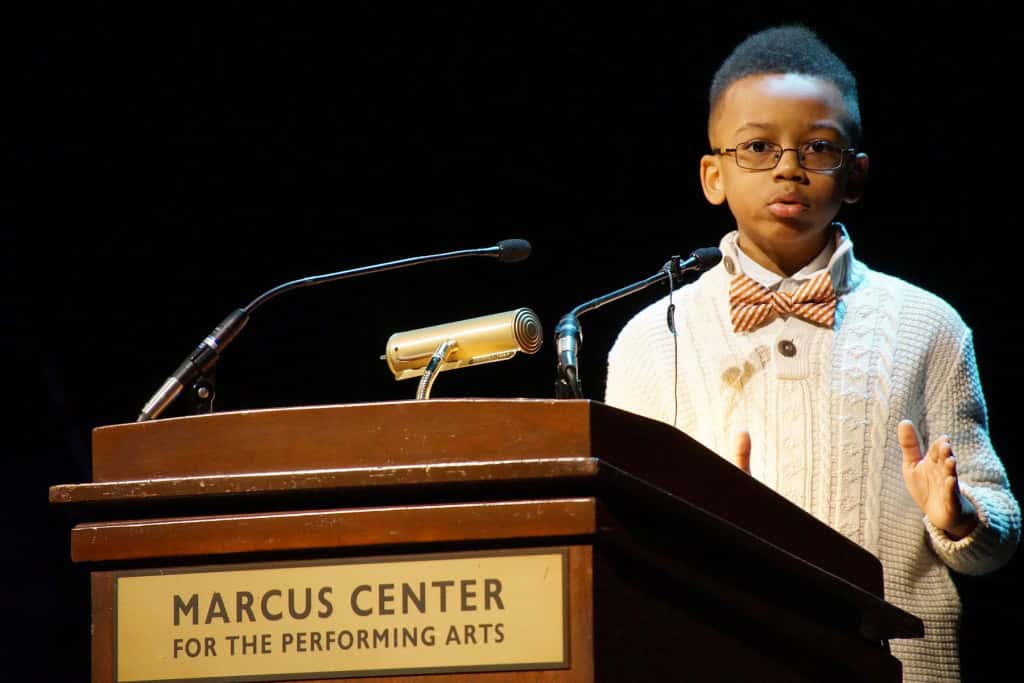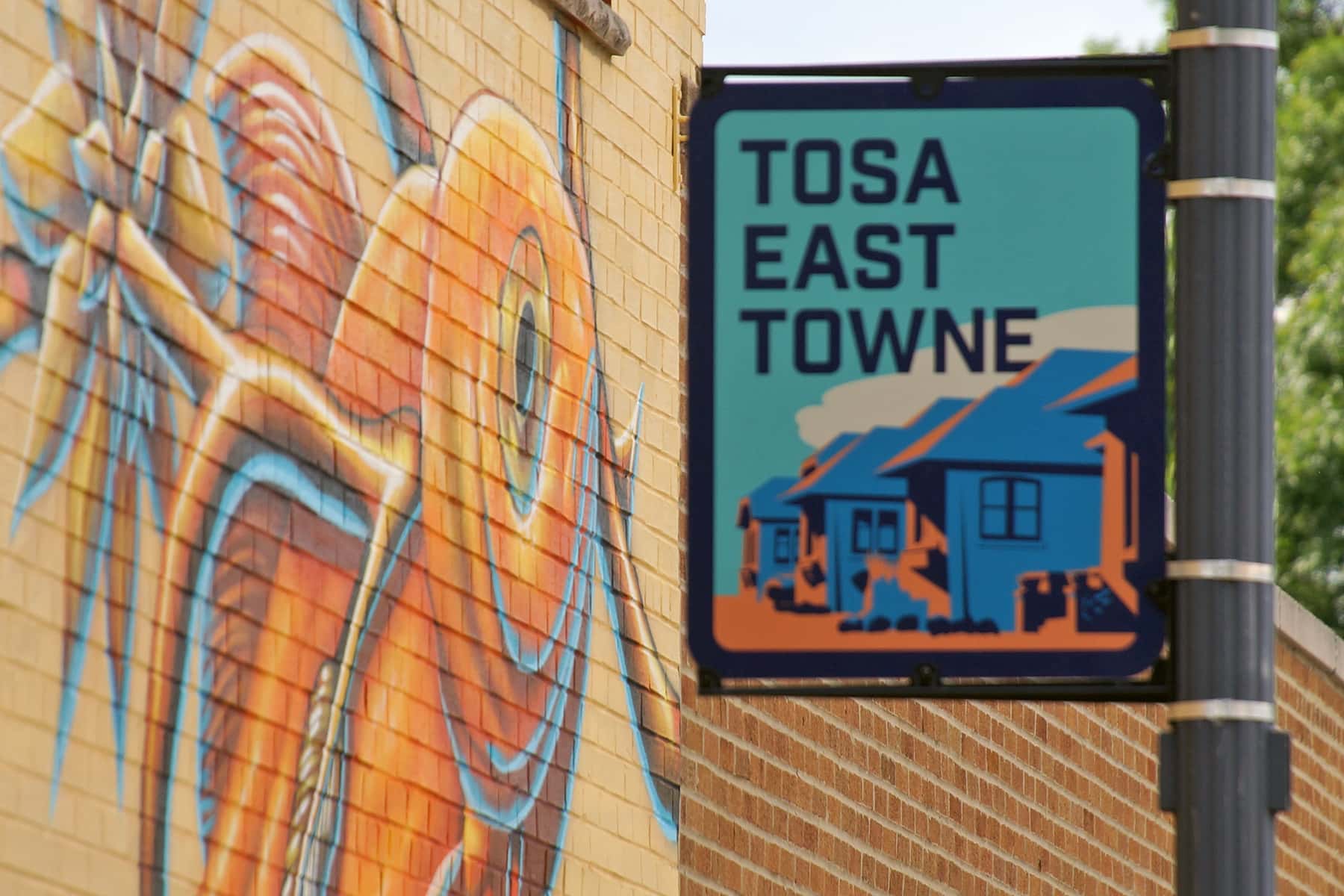
If you’ve driven or walked on North Avenue recently, in the East Towne corridor of Wauwatosa, you’ve surely encountered a satiated racoon and a glaring tiger, a pinball spiral and fluid figures, a hummingbird mandala and swimming goldfish, a cloaked woman emerging from a verdant forest.
Seven artists – local, national, and international – spent two weeks in July bringing new life to the already up-and-coming stretch between 65th and 71st Streets, which is now more than a destination for food, yoga, and flowers – but also for beautiful art. As one of the jurors who helped choose the seven finalists, I wanted to make sure I got to know the muralists during and after their creative process. With the assistance of Stacey Williams-Ng and Judi Kagen of Wallpapered City, I discovered a rich conversation about becoming an artist, the power of story and the unique role of street art.
The seven murals join those in the East Side’s Black Cat Alley to form endpoints between what will eventually be the North Avenue Mural Arts District (NoMAD), linking Milwaukee’s communities with public art along the roughly six-mile corridor. NoMAD is the combined brainchild of Tosa Alderman Joel Tilleson (District 5) and Wallpapered City, the consulting agency responsible for the curation of the alley, Bay View’s Street Canvas project and, most recently, Koctel Kahoolawe’s whimsical art outside the Crossroads Collective and Case Maclaim’s massive mural in the Third Ward honoring the women who used to dye nylons inside the building. Antoine Carter joined with Williams-Ng and Kagen to expand the mission of Wallpapered City, which is rapidly changing the face – or the façades – of Milwaukee. I was privileged to be a part of the process with them and Tilleson to review the hundreds of submissions send from all over the world for the Tosa street art project.
These once flat, blank walls now draw viewers into their mesmerizing patterns or seemingly swim, fly or spiral out of the bricks. Not a day goes by when I don’t see a father taking a photo of his daughter in the parking lot of Bel Air Cantina, whose exterior wall used to be charcoal grey but now pops with Adam Hernandez’s “Tiger Godmask.” Or friends taking selfies in front of Dan Leonard’s “Roan the Racoon” or Ivan Roque’s “A Life of Gold.” Or patrons at the flower shop studying the intricacies of Nykoli Koslow’s “Myth Spinning,” an addition to the NoMAD project made possible by a sponsorship by TripSavvy. The other artists are Eric B. Ricks, whose “Chasing the Sweetness” now graces The Nobleman; Matthew Mederer and Max Komarov, who covered the front of the Voline Service Station with “Whoopsie Daisy;” and Christina Thomas, whose mural “What Blooms is Us” is down the block on the Heartland Information Service building.
But while Wauwatosans and residents throughout Milwaukee will enjoy the vertical vibrancy for years to come, what most of them won’t ever know are the stories behind the art. Street art – associated, in the past, with graffiti or vandalism – doesn’t come with the fancy placards with bios and artist statements one finds in galleries and museums. Therefore, the interviews revealed that behind the art are many stories – of life experiences, personal philosophies and visions for the world. What I’ve woven together here are imagined conversations between those stories to create a more cohesive sense of the new murals of Wauwatosa.
On Becoming An Artist
MILWAUKEE INDEPENDENT: Does a street artist – or any kind of artist – need formal training?
IVAN ROQUE: I’m a Cuban-American from Miami, Florida. Miami is a mural paradise with art from artists all across the world. I started painting professionally back in 2010 and did my first solo mural in 2013. Although I am classically trained with a Bachelor of Art in Fine Arts degree with a minor in Art History, I learned to paint murals and work a can on the streets of Miami by observing much more established artists, all the while taking much of their advice.
ERIC B. RICKS: I learned from others as well. When I first got the courage to tell my mom that I wanted to quit my day job and become a full-time artist, it was like I was coming out of the closet! My family were intellects, all school people, so to have any validation, you needed a college degree. I didn’t want that for myself. When I left the civil war in Liberia, my last level of education was the sixth grade, which I failed twice, not because I was dumb but because I hated school. I wasn’t being challenged. I didn’t really start to learn until I left high school and I got that propaganda out of my ear and said, “I’m not here to recite and be a memory machine. I’m interested in critical thinking and if you don’t challenge me, I’ll get bored easily. And if I get bored, I’m going to find something else to entertain me. I wanted something that was going to challenge the crap out of me. However, after I decided to go a different route, I realized that I would need education from somewhere in order to evolve as an artist, so I, too, tried the formal route. When that didn’t work out, I found an older accomplished artist and he became my mentor.
ADAM HERNANDEZ: I know what it’s like to have a mentor, too. Even though I didn’t go to art school, my family was always super creative. My dad had a 9-to-5 job, but he also did clown parties and stuff as a side business – so I come from fun and eccentric people! My grandfather was an oil painter, and he was the one who taught me how to blend colors. I remember being only about 4 or 5 years old, and he taught me how to blend red and brown. One of my early memories is watching him blend that brick color, and a spark went off in my mind – it was like magic for me.
DAN LEONARD: What I loved watching were cartoons, ever since my childhood in England. I appreciate graphic simplicity, things like the cartoons on the ‘90s Cartoon Network and Nickelodeon. And American sports logos were something else that inspired me to draw. I did study animation in college and graphic design later, but now that I’m based in Kilkenny, Ireland, and a lot of my work depicts wildlife, I attribute that to my mother teaching me to have respect for and be interested in animals.
MATTHEW MEDERER: Me, I’m more monkey see, monkey do. I don’t have any formal training. For me, I’ve been making art since I was a child. It’s intuitive. What inspired me was graffiti. I did about 15 years just painting graffiti in New Jersey, where there is, was, and hopefully always will be a vibrant street scene.
CHRISTINA THOMAS: Like some of you, I did my undergrad studies, but I wanted to study art. I honestly didn’t feel capable of being an artist. I didn’t know if that was something I could do.
ERIC B. RICKS: My mentor said, “To become a working artist – and not an art educator – you don’t need a license to practice. You just have to give yourself permission to work hard, and once you’re good enough, nobody can deny you. No one’s going to look at your degree.” That gave me so much courage. And I like the fact that the masters of the past went through the mentorship practice. How about finding a living, working professional who’s highly proficient at their craft and learn from them? They can teach you not just practical information about how to become an artist but also show you how to apply it, how to be a businessman, a sustainable living artist.
CHRISTINA THOMAS: I eventually did feel drawn to art therapy. This was a rewarding thing for me at the time because the focus was on the process of making versus the outcome. That really helped me a lot. I volunteered with art therapists and although it brought something out in me, I observed that the therapists were more focused on people who were isolated from the world, while I knew I wanted to do community-driven work. So I went back to school for business. I started to think about things that would grow me and set me on a bigger path. I still knew I wanted to be a maker, though. I just need to know how to grow that brand. Once I started making, I started to realize there was already an arts community in Milwaukee and Madison that I could be a part of, and I knew I wanted to grow relationships, have art be a source of healing and promote inclusivity.
NYKOLI KOSLOW: Speaking about inclusivity, it’s not immediately apparent that all of my work is semi-autobiographical in that it reflects my unease with gender dysphoria and a desire to unravel my body and the space around my body. My work is also part research-based, where I tell my story through the story of trans deities, peoples and concepts that I’ve found in ancient history, mythology and various religions around the world. Growing up in the ‘90s, trans people were non-existent to me. There was no one who reflected what I felt, so my sense of self was also non-existent. I didn’t know trans people existed until an embarrassingly late age and even then, for all my queerness, I had no history, no culture, no religion, and no space in which to exist. So now, as an adult, I dig into research and pull from history all the queerness I can find, and where there is no queerness, I create it – this is what I call “myth spinning.” We all spin myths. It’s how we create the world we live in. We can spin a myth that “others” and alienates people or spin myths that celebrate and center around that “otherness” and “alienness.”
On Meaning and Message
MILWAUKEE INDEPENDENT: Working off of what Nykoli has said about “myth spinning,” does street art have to come from some kind of grand vision of the universe that wells up from one’s inner being? Or can it be just fun or beautiful? Does it have to have some kind of symbolism or hidden meaning?
MATTHEW MEDERER: We really just like to play with light.
DAN LEONARD: And I will often paint animals that are common in the mural’s region. For Tosa, I chose a racoon and decided to name him after my son, Roan. “Roan the Racoon.”
CHRISTINA THOMAS: My work is more symbolic. “What Blooms is Us” is meant to inspire unity in the people in our community, personified by the symbol of Mother Nature. I made her stature a big presence, and there are icons embedded throughout, especially flowers and other botanicals, which symbolize the growth of Wauwatosa in particular but also the growth and resurgence of the whole community.
IVAN ROQUE: The symbolism behind “A Life of Gold” is good fortune, bright days and prosperity. The inspiration behind the piece is Eastern philosophies and ideas, as yoga originates from Asia. After much research, I decided to go with the goldfish, a symbol of luck and wealth in Asian culture.
ERIC B. RICKS: My mural concept is also symbolic, as well as inspired by Asian culture. It’s a blend of the structure of man and the natural form of Nature. I tend to blend geometric, mathematical structures and organic shapes or themes. There’s a nice balance between the two: a straight line is man’s invention and man’s living in an organic world. The mandala design, pulled from Tibetan Buddhist tradition, is a reminder to be more present because life is fleeting and all of our straight lines are going to fall to dust. That’s the wonderful thing about the human experience: we are promised to not be around forever, so the more we can look at it not from a morbid stance but look for the beauty around us, it will enrich the time that we do have. In my work, I make a conscious effort not to focus on the dark side of things – I’ve seen and experienced enough of that – but to reinforce the beauty that is, even in the darkness.
IVAN ROQUE: In my mural, the thorns are life obstacles that we must overcome, and the vines represent the energy and time that connects us all.
ERIC B. RICKS: It takes time and effort to overcome obstacles. That’s one reason the hummingbird and butterfly are common motifs in my work. The hummingbird is kind of my totem animal. Besides always living off the beauty and sweetness of life – the title of this project is “Chasing the Sweetness” – it is one of the smallest, hardest working, most disciplined and most precise of all the fliers. That level of control and precision is something that I like to show in my work. And the butterfly effect, of course, says that something so delicate and fragile and seemingly insignificant can have power to impact change in the world.
ADAM HERNANDEZ: I’m also thinking about how to change the world in my work. I’m doing a whole series of what I call “godmasks,” inspired by masks that shamans or religious leaders used to wear in tribes and ceremonies Central and South America, such as the Aztecs and the Mayans. The multiple eyes represent how we see beyond the physical world. People talk about the third eye, and while I don’t consider myself religious, I’m open to the idea that there’s something more to the world we live in. These pieces are a challenge to people to look beyond the surface of their lives and to seek deeper connections.
NYKOLI KOSLOW: Speaking of wearing masks, the mural design came from a collection of very small paintings, some just 2 x 2 inches, that were digitally collaged together to fit the dimensions of the wall and to tell a larger narrative. These small paintings are part of an ongoing series that explore gestural mark making as a means to build a visual vocabulary. Each painted gesture acts as a letter of an alphabet that, when strung together, tells a mythic story. These stories, though abstracted, are all part of my own personal cosmology that is intended to create a space of belonging and freedom for “weirdness” of any kind to exist in. For me, that “weirdness” has been my trans-ness and gender non-conformity. For others, if may be any aspect of themselves they feel they need to keep hidden or suppressed in order to fit in. The full title of the mural is “Myth Spinning: The Fiery Bythos and the Forgotten Salmacis.” Bythos is the Gnostic term for the primal being, the primordial state of the cosmos. It means “depth” and is the source of all things in the manifested universe. Usually associated with the depth of the seas and water, I made the water fiery as I associate fire with will power and the act of creation. The two creatures on the ends of the building have the fire in their bellies to represent the passion and will to exist and create. Salmacis is a water nymph who swallowed up her lover Hermaphroditus. The two became one and in turn, and ironically, her identity was swallowed by Hermaphroditus and she was forgotten by history. She is represented by all the mouths, and because she has been forgotten, she has no body. The water in Salmacis’s fountain was supposedly “cursed” by Hermaphrodite to have the effect of making men effeminate and women masculine. The fluidity of gender and identity, then, is also represented by the fluidity of my “watery” mark-making. The open mouth motif in this mural, as well as much of my other work, also represents the unleashing of one’s personality. Ancient Egyptians would open up the mouth of the dead to release the individual’s inner Ba, or their instincts and personality, from their body. So often I feel I can’t speak up for who I am. I feel I am continually swallowing, or apologizing for, my inner Ba. So in my work, the mouth is open to release a personality and this personality affects the ‘waters’ so to speak in which it exists in.
ADAM HERNANDEZ: I haven’t always been a super self-confident person myself, so I think of masks this way: if I had the opportunity to wear the mask of a confident beast like the one in my mural, maybe I could assume its power to make a difference in the world around me. I could have the magic eyes to have deeper perception and look deeper into the world.
On Legitimizing Street Art
MILWAUKEE INDEPENDENT: Finally, does street/mural art serve a special purpose? Does it have a different role than fine art in a gallery or museum? Should it be easy to understand/enjoy/consume or should it invite interpretation/provocation/disturbance?
MATTHEW MEDERER: I’m not sure if street art, graffiti or any kind of public expression serves a special purpose in Art with a capital A. But I know it’s given me purpose.
IVAN ROQUE: I think, though, that street art most definitely serves a special purpose because it’s the artform that’s closest to the people and creates a direct effect on society.
CHRISTINA THOMAS: In ways that no other form of art can.
MATTHEW MEDERER: I did hear this story recently that a baby doesn’t know it’s separate from its mother or that it can have any effect on the world for a while after it’s born. But around 6 or 7 months old, it bumps against something, and that something moves, and the baby realizes, Hey, I can do something. When the baby realizes it can have an effect on the world, it’s usually followed by a high degree of delight. We’re in a world where you don’t really have a chance to affect anything when you’re a kid. In many cases we end up in a job where we can’t really see how our small role in the larger tasks matters. It’s nice to be able to go into a community and make something that wasn’t there, meet new people, and have a sense that you made some small change.
IVAN ROQUE: Yes. What I love most about murals and street art is the fact it connects me with the public and its surroundings. It’s art for the people whether you’re into it or not.
MATTHEW MEDERER: Street art is definitely a way to interact with people.
CHRISTINA THOMAS: I met all sorts of people from around the neighborhood and who work for the city that I never would have met otherwise, even though I am local to Wauwatosa. I could tell that my artwork had a stronger impact because people were able to talk with me and hear my feelings about the work in person. Street art is more accessible and less intimidating than walking into a gallery.
IVAN ROQUE: The difference between the art that lies in the gallery and those that tower over the paved streets is that the first is needs to be sought while the second is just found. In order to see a gallery piece one must want to accept art and go search for it while a mural is like an entity that is released to the world, vulnerable to whatever life throws at it, yet it stays still waiting for what’s to come. When a mural is born, it becomes an instant landmark that evokes an array of emotions from all walks of life. It can be pure beauty or spread a message. Some marvel in its presence while others detest it.
NYKOLI KOSLOW: And that’s ok. Yes, we need beautiful objects and images that are universally understood; this grants comfort and order. But we also need weird stuff, undefinable stuff, stuff that doesn’t make sense right away. We need art whose processes reflect the fact that our lives are not always clean cut, our future not always fixed. People are messy, kinky, multifaceted in their eccentricities and, at times, impossible to understand. Why not embrace this in our art?
ERIC B. RICKS: In a way, I disagree. Mural art which is out there in the public sphere should not be something that’s divisive for the community. Public art is a responsibility. We already live in a highly divided world with different opinions, so public art shouldn’t be a place for more opinions. For me, coming from a spiritual background, public art should be a place of healing, creating in the public sphere to bring people together and facilitate healing. I really take my duty as a public artist seriously, especially as a healer. I want to leave something behind that’s a catalyst for the healing process.
IVAN ROQUE: I feel street art should be whatever the artists wants it to be. There are plenty of spaces to make that choice and while I feel its very important to create dialogue I can understand the need to just fully express oneself. That’s the beauty of the world we live in. There’s enough room for everyone.
ERIC B. RICKS: In private art, of course, there’s room for opinion and contention. But in public art, I don’t want to create something where you have to read an explanation for my intention. Over the years, I’ve evolved to the point where I want to tell a positive story because every viewer tends to create their own story. I want them to immediately read something positive without having to have contextual information. Public art should be palatable where it is. Everything has its proper place and setting and forum.
ADAM HERNANDEZ: I know that, on the surface, the meaning of a piece might not necessarily be apparent, but I do know that all our murals are thought provoking. I mean, mine has a tiger with six eyes!
CHRISTINA THOMAS: And even though the artist might have a few ideas in mind when creating a piece, viewers bring all of their own additional insights. While creating a piece of public art, the artist can be there for a brief period to explain their intentions, but then they give it away and it’s entirely out of their hands how it is perceived and interpreted and that only will ever extend more substance to the piece.
NYKOLI KOSLOW: With my piece, while there is a specific story in which I’m working from, ultimately my hope is that when people walk past, they do their own myth spinning, tell their own stories and bring their own magic into the mix.
ADAM HERNANDEZ: At the very least, I know it brightens their day. I know that street art beautifies the neighborhood. We live in an ugly world, in many ways, so to be able to brighten it, I feel really blessed. It’s also just a lot of fun! You know?
NYKOLI KOSLOW: I like to think that my mural – in all its otherworldly-ness, full of androgynous, “morphic” creature bodies and galactic elementals – grants people permission to loosen up, be their full selves, and stay “queerious” about their own internal natures.
ADAM HERNANDEZ: I really just like that I know a lot of people are going to see it.

